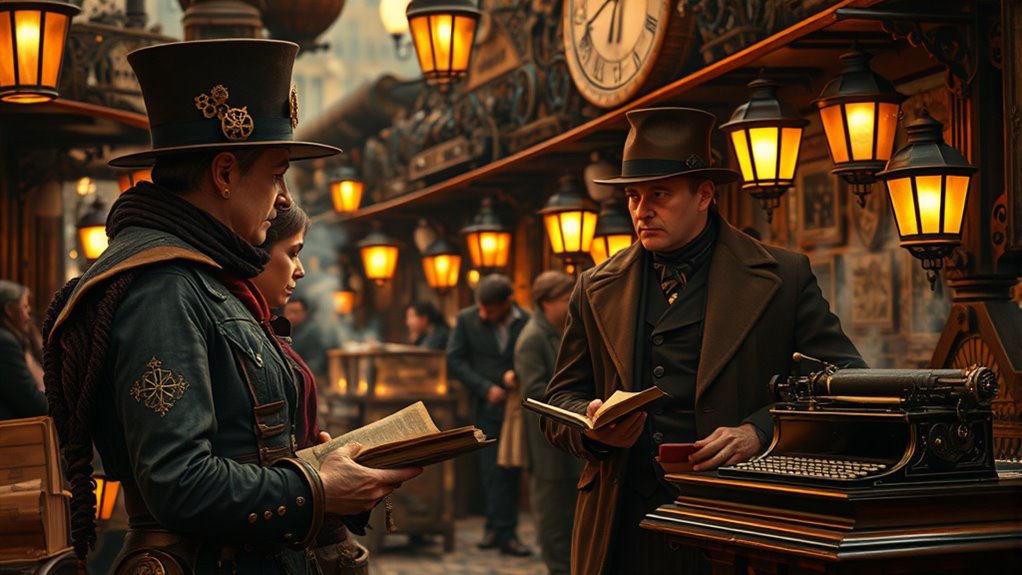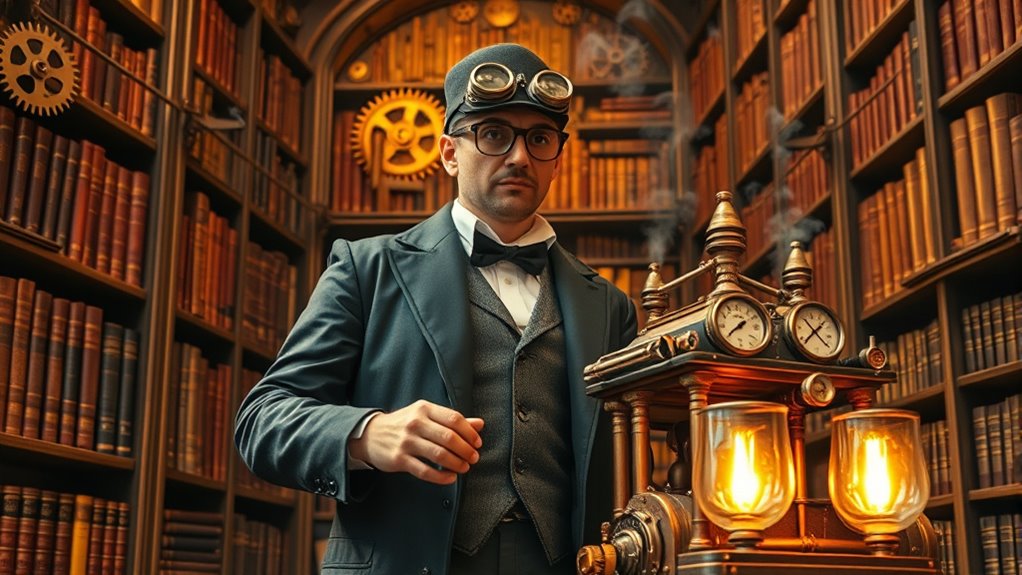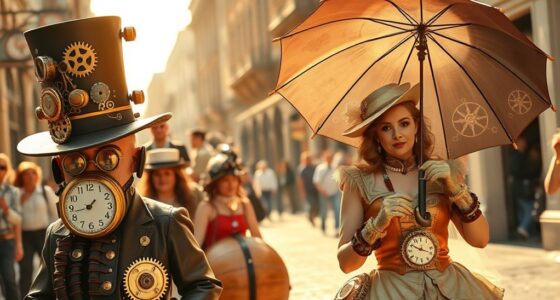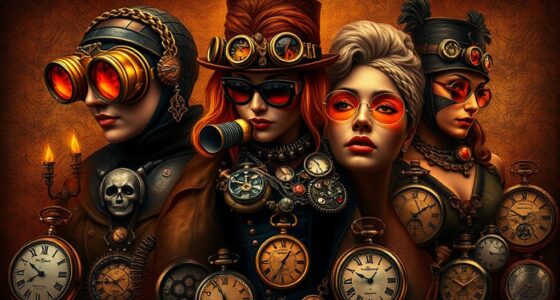In steampunk fiction, language and dialogue are key tools to transport you to a Victorian-inspired world. You’ll notice the use of period-specific slang, formal speech for the upper class, and rougher dialects for working-class characters, all shaping the atmosphere. This careful crafting makes the setting feel alive and authentic, blending technological optimism with historical charm. If you keep exploring, you’ll discover how these linguistic choices deepen your immersion in the steam-powered universe.
Key Takeaways
- Victorian slang and formal language evoke the era’s atmosphere and enrich world-building.
- Dialogue reflects social class and regional accents, adding depth and authenticity to characters.
- Language choices set the tone, blending elegance and industrial grit to create a vivid mood.
- Use of period-specific words immerses readers in the steampunk universe’s linguistic landscape.
- Authentic dialogue enhances realism and fosters a stronger connection to the story’s Victorian setting.

Have you ever wondered how steampunk fiction captures its unique atmosphere through language? It’s all about the way characters speak, the slang they use, and the dialects that lend authenticity to the setting. When you immerse yourself in a steampunk story, you’ll notice that dialogue isn’t just filler; it’s carefully crafted to evoke a bygone era filled with Victorian elegance and industrial grit. To achieve this, authors often incorporate Victorian slang, sprinkled throughout conversations to give characters a sense of time and place. Words like “blighter” or “dandy” aren’t just throwaway terms—they’re clues that transport you to a world where language pulses with historical flavor. Using these slang expressions helps immerse you in the story, making the characters’ voices feel genuine and rooted in their era.
Moreover, dialect authenticity plays a fundamental role in creating a believable steampunk universe. Different regions or social classes might speak with distinct accents or speech patterns, and authors often reflect this in their dialogue. For example, a working-class inventor might speak in a rougher, more colloquial manner, peppered with slang and idioms of the Victorian age, while an upper-class aristocrat might use more refined, formal language. This variation in speech adds depth to characters and makes their interactions more realistic. When you listen closely, you can pick up on subtle cues—how a character emphasizes certain words or uses specific expressions—that reveal their background and personality. These dialect choices aren’t random; they’re deliberate tools to enhance the authenticity of the Victorian-inspired world. Incorporating authentic language further enriches the narrative by grounding fantastical elements in a believable linguistic setting.
Authors also use language to set the tone and atmosphere of their stories. The blend of Victorian slang and dialect creates a linguistic tapestry that feels both familiar and fantastical. It transports you to a time when steam-powered machines roamed the streets, and society’s speech was colored by the social norms and technological optimism of the era. This careful language craftsmanship helps you feel like you’re stepping into a Victorian city teeming with inventors, adventurers, and inventiveness, all brought to life through the way characters speak. When dialogue is authentic and richly textured with period-appropriate slang and dialect, it becomes an essential part of world-building. It’s not just about what characters say, but how they say it—an indispensable ingredient that makes steampunk fiction stand out and feel truly immersive.
Frequently Asked Questions
How Does Steampunk Dialogue Influence Character Development?
Steampunk dialogue shapes your characters’ development by showcasing their linguistic diversity and unique voices. When you craft distinct speech patterns, it reveals their backgrounds, beliefs, and personalities, making them more believable and relatable. As you use specific language choices, you deepen their identities and motivations. This active voice approach helps your readers connect with characters on a personal level, highlighting how dialogue influences their growth and interactions within the steampunk world.
Are There Regional Dialects Commonly Used in Steampunk Stories?
You’ll find regional dialects often add a charming layer of complexity to steampunk stories, despite the irony that this genre’s Victorian-inspired setting should be more uniform. Expect to hear regional slang and dialect diversity that paint vivid images of characters’ backgrounds, from Cockney accents to Southern drawls. These linguistic quirks enrich dialogue, making characters feel more authentic and grounded in a richly layered, steam-powered world.
How Does Language Evolve in Steampunk Worlds Over Time?
In steampunk worlds, language evolves through a blend of anachronistic slang and technical jargon, reflecting technological progress and cultural shifts. You’ll notice characters adopting new terms to describe inventions or societal changes, which keeps dialogue fresh and immersive. As time passes, these words often shift meanings or fall out of use, creating a dynamic linguistic landscape that mirrors the complex, layered history of the steampunk universe.
What Are Common Linguistic Tropes in Steampunk Fiction?
You’ll notice steampunk fiction often uses inventive slang and Victorian expressions to create an authentic atmosphere. These linguistic tropes help immerse you in a world blending old-fashioned charm with futuristic inventions. People frequently use elaborate, formal language mixed with quirky terms, reflecting both the Victorian era’s social norms and the inventiveness of steampunk culture. This combination makes dialogue lively, colorful, and distinctly steampunk.
How Do Authors Balance Historical Authenticity With Creative Language?
You balance historical authenticity with creative language by blending Victorian slang and technological jargon naturally into your dialogue. You use authentic terms sparingly to evoke the period without overwhelming the reader, ensuring dialogue remains engaging and believable. Incorporate technological jargon to highlight steampunk’s inventive world, but stay true to the era’s speech patterns. This mix keeps your world immersive, authentic, and lively, appealing to fans of both history and creative storytelling.
Conclusion
As you close the book, you’re transported to a world where language sparkles like brass gears and dialogue hums like ticking clocks. The steampunk universe wraps around you like a velvet cloak stitched with Victorian elegance and industrial grit. Every word dances like steam rising from a boiler, blending old-world charm with futuristic ambition. In this domain, language isn’t just spoken—it’s an intricate dance of invention, inviting you to explore a universe where words breathe life into mechanical dreams.









